For more information and to RSVP contact Alicen.Morrison@scranton.edu / 570-941-6206
For more information on upcoming Schemel Forum events, click here.
For more information and to RSVP contact Alicen.Morrison@scranton.edu / 570-941-6206
For more information on upcoming Schemel Forum events, click here.
On display in the Weinberg Memorial Library’s Heritage Room is a collection of pen and ink portraits of late 19th and early 20th century theatrical personalities drawn between 1905 and 1930 by Scranton’s Master Penman Patrick W. Costello. Costello was nationally recognized for his work and operated what we might now consider a graphic arts studio where he created advertising art as well as engrossed congratulatory or testimonial resolutions, diplomas, and other types of work that required a combination of calligraphic lettering and artistic design. As a hobby, Costello drew pen and ink portraits and, because he had a love for the theater, specialized in drawing portraits of stage personalities. These were often drawn from photographs, engravings or illustrations found in theater magazines and books, but he also drew some portraits from life. In addition to his career as a penman, Costello owned restaurants in Scranton where he would display his portraits. In some cases, traveling actors would visit the restaurant and autograph their portraits. The exhibit will include a variety of men and women of the stage, some of whom played Scranton. Some actors, such as John Barrymore, are still famous today. Many of these actors performed Shakespeare and, therefore, a portion of the portraits on display depict Shakespearean characters.
The Heritage Room will host an exhibit reception and program on Tuesday, March 27 at 6 PM. Thomas W. Costello, P. W. Costello’s great-grandson, will speak on Costello’s career. University of Scranton English professor Michael Friedman will give a talk titled “Shakespeare on the Stage in 1900: From Actor’s Theater to Author’s Theater.” Sponsored by the Friends of the Weinberg Memorial Library, the reception is free and open to the public. The exhibit will run from February 5 through April 23 during normal Library hours. Images of the portraits can also be viewed through our digital collections website. For more information, please email archives@scranton.edu or call 570-941-6341.
For more information and to RSVP contact Alicen.Morrison@scranton.edu / 570-941-6206
For more information on upcoming Schemel Forum events, click here.
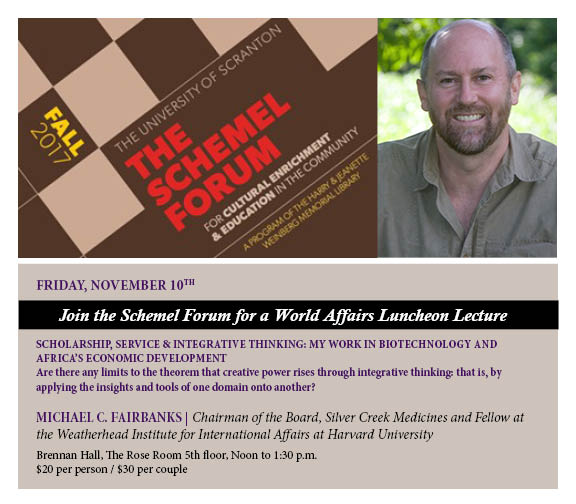
For more information and to RSVP contact Alicen.Morrison@scranton.edu / 570-941-6206
For more information on upcoming Schemel Forum events, click here.
The Pennsylvania Historical Association’s annual conference begins tonight with a plenary session in the Heritage Room that will discuss the World War I exhibit currently on display. WBRE/WYOU-TV featured the exhibit in today’s broadcast, which can be viewed here: http://www.pahomepage.com/news/exploring-the-history-of-scranton/833696618.
The plenary session will take place in the Library’s 5th floor Heritage Room from 7:30-9:00pm. This event is free and open to the public. The exhibit will remain on display during normal library hours through Friday, December 8th. For more information, please email Special Collections Librarian Michael Knies, michael.knies@scranton.edu or call 570- 941-6341.
Currently on display in the Library’s 5th Floor Heritage Room is the exhibit “Scranton and World War I.” The exhibit is a cooperative effort with the Lackawanna Historical Society in conjunction with the Pennsylvania Historical Association‘s annual conference which will be held at the Radisson Hotel from October 12 through October 14. The conference’s opening reception will take place on Thursday, October 12 at 7:30 p.m. in the Heritage Room. This event is free and open to the public. The exhibit is composed of World War I era materials that relate to Scranton from the Lackawanna Historical Society and The University of Scranton Archives, as well as materials from the Zaner-Bloser Penmanship Collection, the International Correspondence Schools of Scranton Collection, and the Visiting Nurse Association Collection.
The exhibit is on display during normal library hours through Friday, December 8th. For more information, please email Special Collections Librarian Michael Knies, michael.knies@scranton.edu or call 570- 941-6341.
A selection of rare materials from McHugh Special Collections is currently on view in the Library’s 5th floor Heritage Room. This week we are highlighting three 18th century liturgical books (2 breviaries and a missal) from the exhibit “From Medieval to Modern”. These books are special for their ecclesiastical coats of arms and elaborate decorated bindings.
The first is the Diurnale Ebroicense (1740) by Pierre Jules César de Rochechouart (1698-1781), a French ecclesiastical man who served as Bishop of Evreux and then as Bishop of Bayeux. A Diurnale is a condensed version of a breviary, and in this case, the summer volume Pars Aestiva, from Pentecost though the 15th Sunday after Pentecost. However, this volume also contains sections for the autumn. The Diurnale Ebroicense is based on the rites practiced in Ebroicense, also known as Évreux, a diocese in northern France. This red leather binding features the coat of arms of an unidentified ecclesiastical, possibly a Bishop.
The next is the Breviarium Romanum (1740), which is a very elaborately decorated breviary that features repeating floral designs on red leather, gilt edges, and the arms of an unidentified ecclesiastical, possibly a Bishop. Finally, there is the Canon Missae. Canon Missae is the name used in the Roman Missal for the fundamental part of the Mass that comes after the Offertory and before the Communion. This impressive volume was printed at the Vatican in 1784. The engraving of the Last Supper was engraved by Carolus Grandi after an original by Joseph Passarus. The ornate gold-tooled binding features rather large floral tools that would have required significant strength to impress into the leather. It also features the arms of an unidentified ecclesiastical, possibly a Bishop.
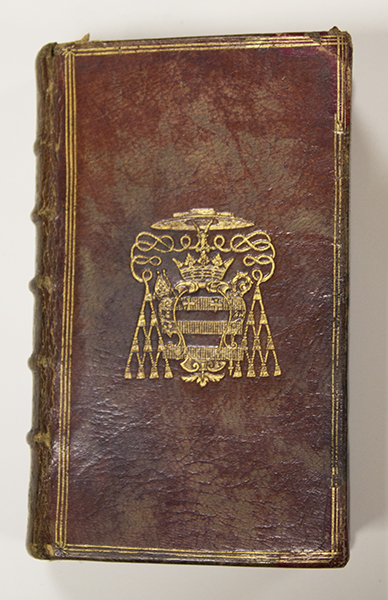
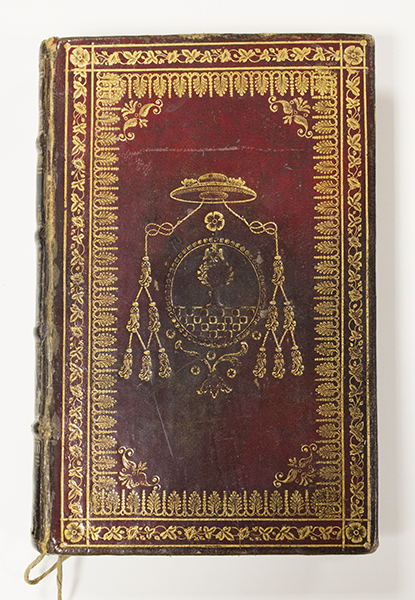
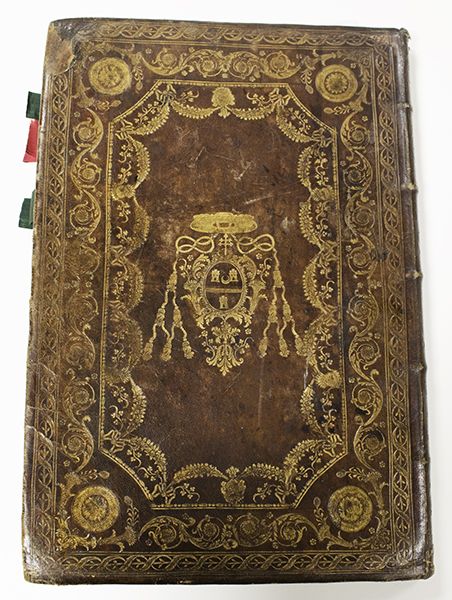
To read more about the Weinberg Library’s Rare Book Collection visit our collection page here. “From Medieval to Modern” will be on display during normal library hours through Tuesday, April 25. On Tuesday, April 11th, Special Collections Librarian Michael Knies will discuss the exhibit at 6 p.m. in the Heritage Room of the Library. A reception will immediately follow the talk. This event is free and open to the public. For more information, please email michael.knies@scranton.edu or call 570- 941-6341.
A selection of rare materials from McHugh Special Collections is currently on view in the Library’s 5th floor Heritage Room. This week we are highlighting the Book of Hours from the exhibit “From Medieval to Modern”.
The Book of Hours was a Christian devotional book that became popular in northern Europe during the 14th century and has been called the Medieval best seller as many educated men and women owned them. The Book of Hours was a distillation, for laypeople, of the series of prayers said by priests, monks, nuns, etc. during the course of the day divided into sections from morning through the night. Although containing a similar collection of texts, prayers, and psalms, there is a high variation in quality depending on the budget of the purchaser. As result, each manuscript was unique with its illumination and binding. Most examples are small books with little illumination, often restricted to decorated capital letters at the start of psalms and prayers. However, the books made for the wealthy can be extremely lavish and heavily illuminated with full-page decorations and have extravagantly decorated bindings.
On display in the Heritage Room are several examples of the Book of Hours from Special Collections: two medieval leafs, a simple book, and a fine art facsimile. The first leaf is from a fine Book of Hours with inhabited borders (ca. 1440). The second leaf is from an undistinguished Book of Hours (ca. 1450-75), but has significance because it records information in French on the Dumesnil family from Loire.
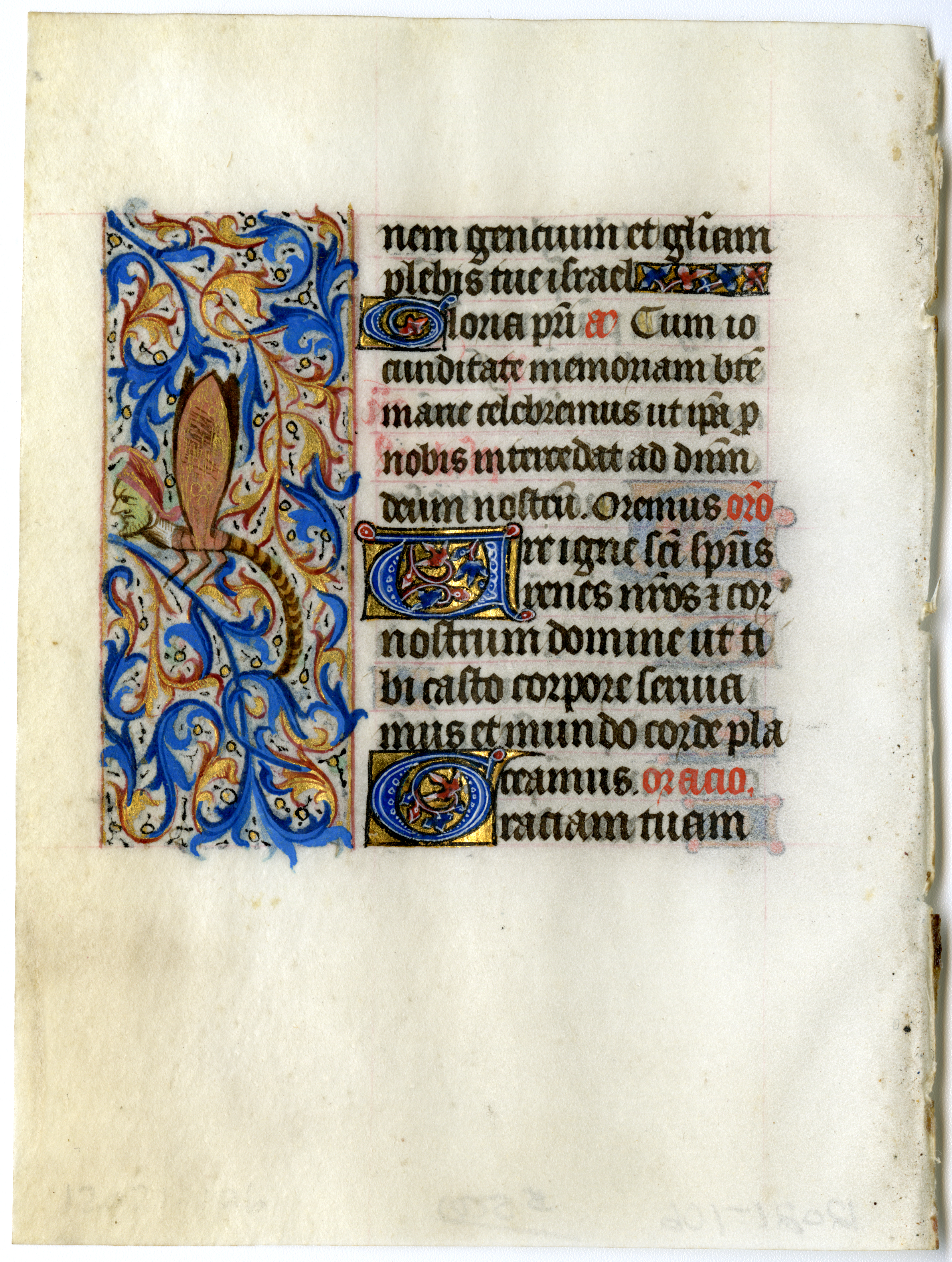
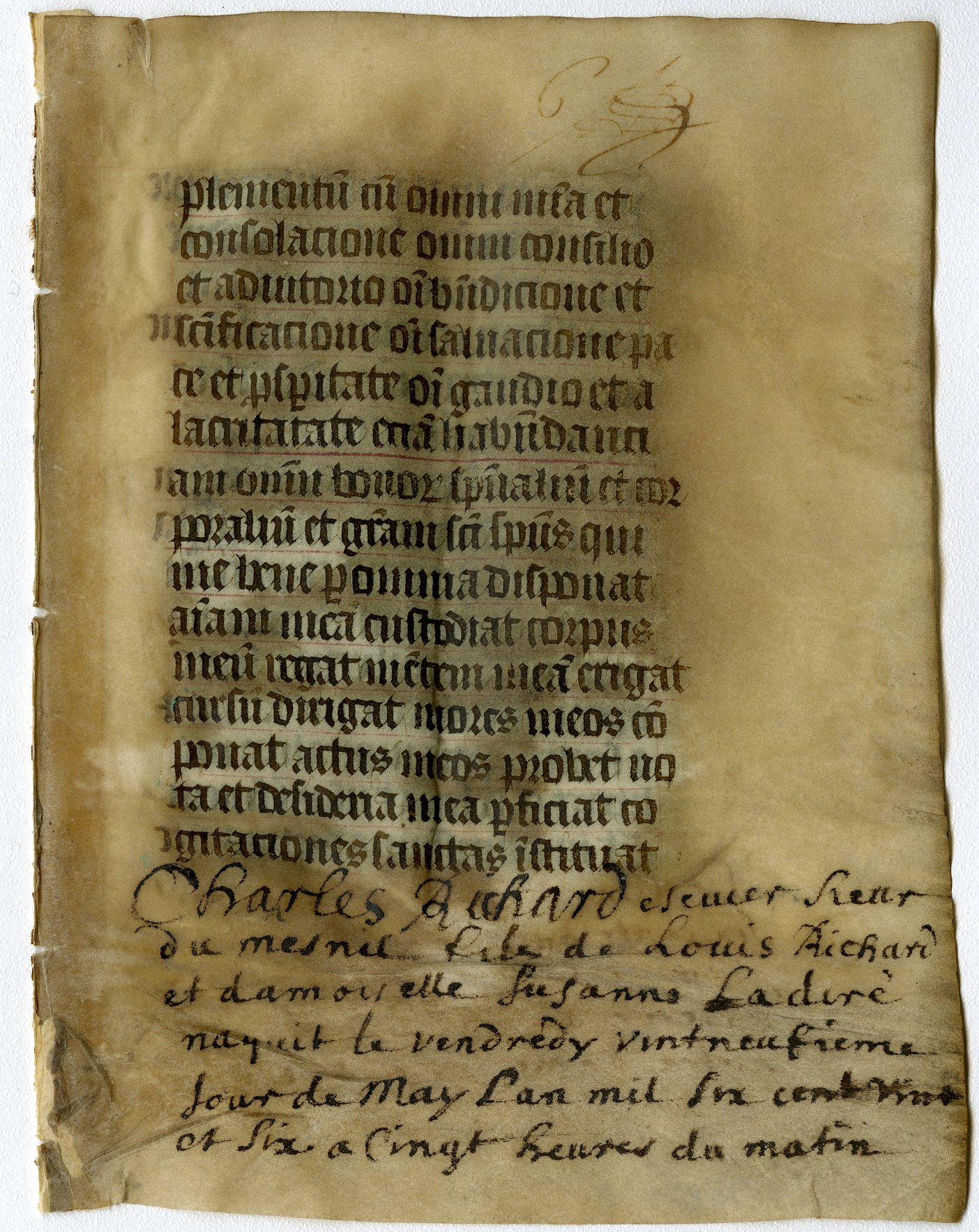
There is a Book of Hours (1685) bound in a simple blind ruled black Morocco. This binding has an unfortunately added shelfmark in addition to damaging adhesive tape. Finally, there is a fine art facsimile of a miniature, illuminated Book of Hours from the Vatican Library in brown leather with raised bands and gilt decoration.
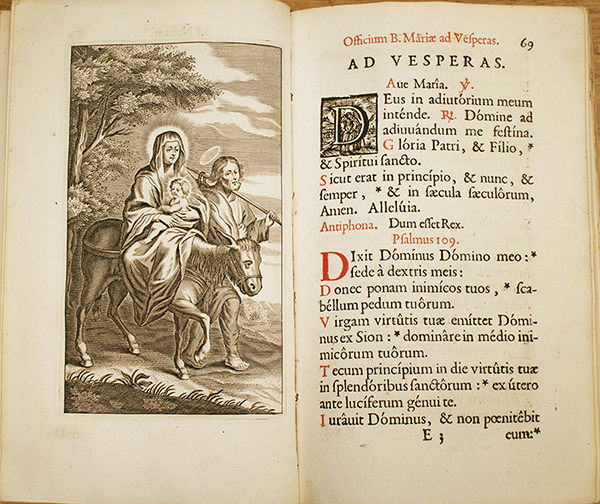
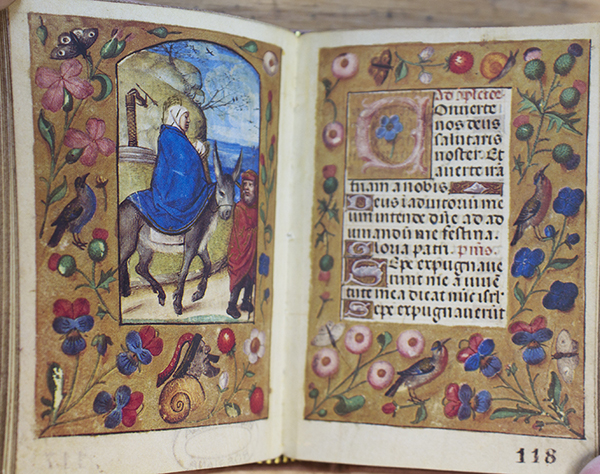
To read more about the Weinberg Library’s Rare Book Collection visit our collection page here. “From Medieval to Modern” will be on display during normal library hours through Tuesday, April 25. On Tuesday, April 11th, Special Collections Librarian Michael Knies will discuss the exhibit at 6 p.m. in the Heritage Room of the Library. A reception will immediately follow the talk. This event is free and open to the public. For more information, please email michael.knies@scranton.edu or call 570- 941-6341.
A selection of rare materials from McHugh Special Collections is currently on view in the Library’s 5th floor Heritage Room. This week we are highlighting two fine art facsimiles from the exhibit “From Medieval to Modern”: The Book of Kells and The Lindisfarne Gospels.
In 1997, Special Collections acquired a fine art facsimile of the Book of Kells, donated by the estate of Charles J. Buckley, a dean emeritus who served the University in a variety of academic and administrative positions for 46 years.
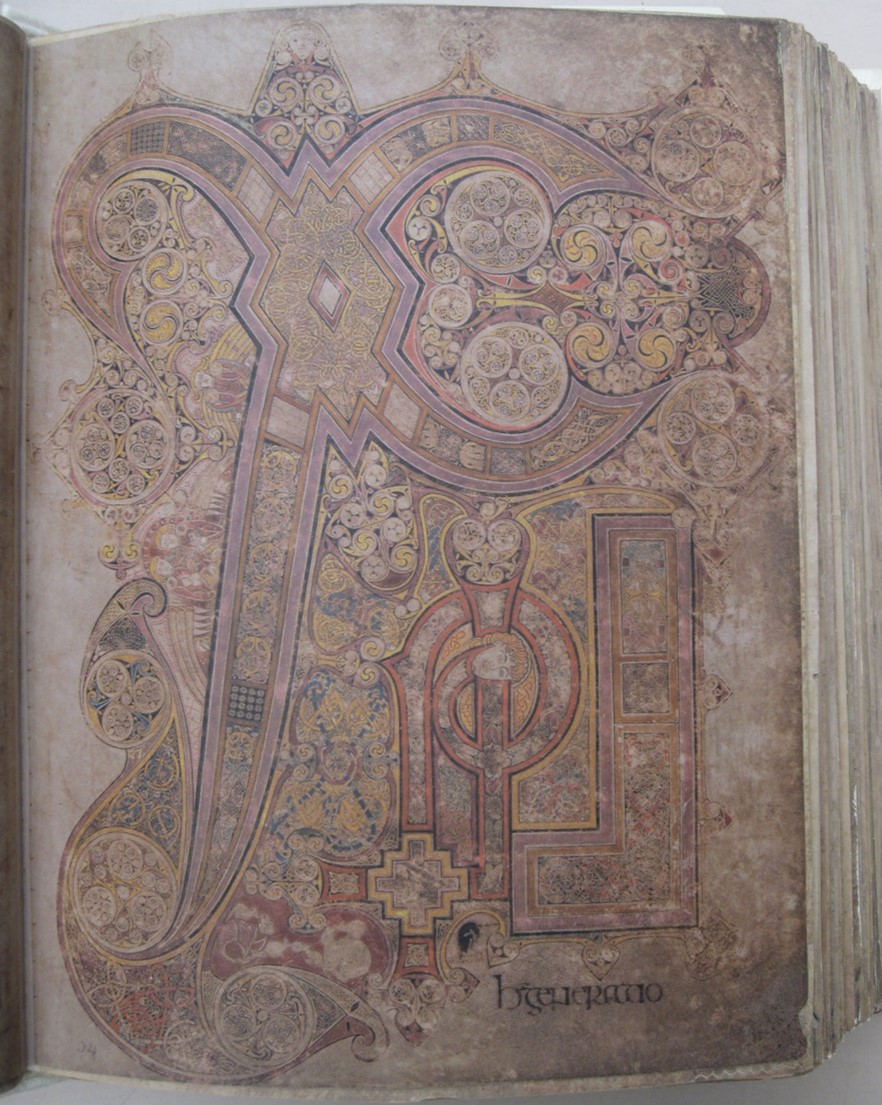
The original Book of Kells is believed to have been created around 800AD on the island of Iona off the coast of Scotland. Since the 17th century, it has been stored in the Library of Trinity College in Dublin. It is one of the world’s most famous illuminated manuscripts and is considered one of the greatest artistic productions of the Medieval period. The Book of Kells is a masterwork of Western calligraphy and represents the pinnacle of Insular illumination. It is also widely regarded as Ireland’s finest national treasure. The illustrations and ornamentation of the Book of Kells surpass that of other Insular Gospel books in extravagance and complexity. The decoration combines traditional Christian iconography with the ornate swirling motifs typical of Insular art. Figures of humans, animals and mythical beasts, together with Celtic knots and interlacing patterns in vibrant colors, enliven the manuscript’s pages. Many of these minor decorative elements are imbued with Christian symbolism and so further emphasize the themes of the major illustrations.
Only 1,480 copies of the facsimile of the Book of Kells were produced by the Fine Art Facsimile Publishers of Switzerland. The facsimile is owned by some of the most prestigious institutions in the United States, including New York’s Morgan Library and the Metropolitan Museum of Art. The facsimile edition took 10 years to produce and is considered to be indistinguishable from the original under museum viewing conditions. This accuracy extends to duplicating any damage and holes that appear in the original. The pages of the facsimile are identical in size and shape to the original manuscript pages. Of most importance to the viewer, however, is the impeccable color reproduction of the photographs. A special photographic book cradle was manufactured to hold the original safely. Kodak Ektachrome color transparencies were color corrected electronically, then passed to a lithographer who made additional color corrections by hand using as many as 10 printing inks per page. As the lithographer perfected the color balance, examples of the pages were compared with the original to fine-tune the color. After the pages were duplicated, they were sewn into gatherings hand-bound in a white skin, a book construction similar to the original.
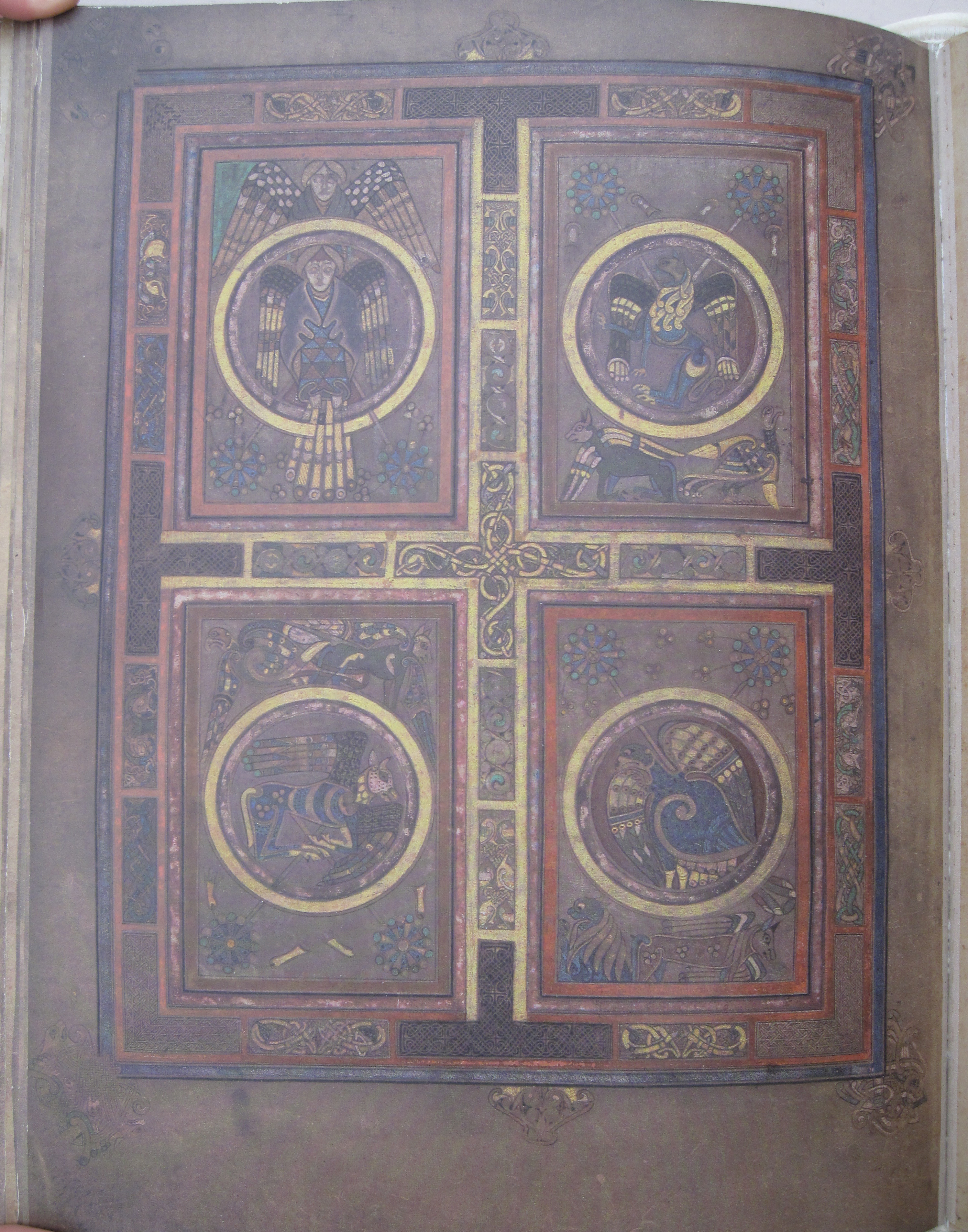
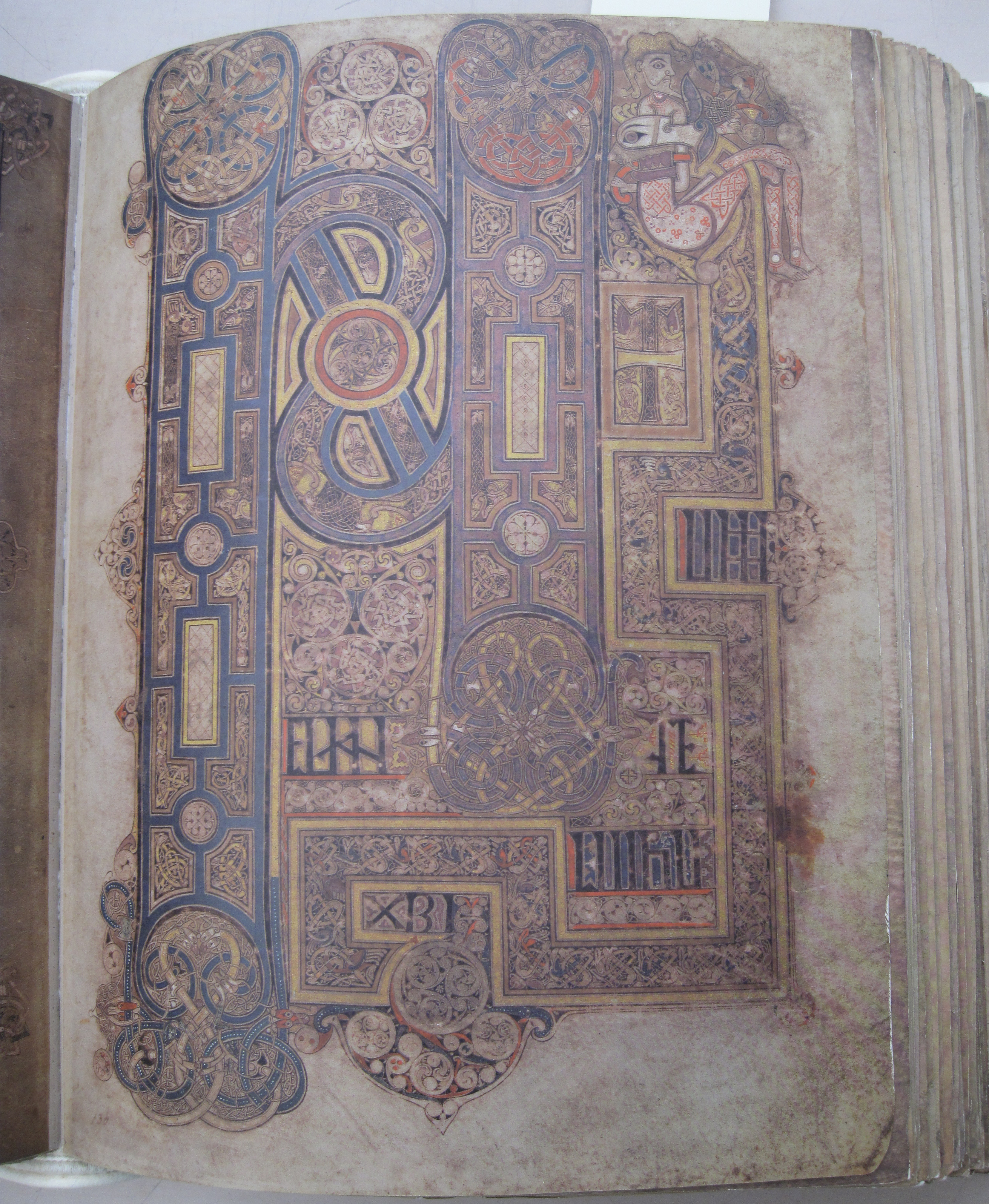
The Weinberg Memorial Library Special Collections recently received an extraordinary gift in honor of the 20th anniversary of the Library. Dr. Midori Yamanouchi, Friends of the Weinberg Memorial Library Board Member, provided funding for the acquisition of a fine art facsimile of the Lindisfarne Gospels. The original Lindisfarne Gospels is at the British Library in London and it is one of the most important and one of the best-preserved early medieval manuscripts.
 The Lindisfarne Gospels is an Illuminated manuscript gospel book created approximately 715-720 AD in a monastery at Lindisfarne off the coast of England. It is considered one of the best early versions of St. Jerome’s Latin Vulgate. The Lindisfarne Gospels also includes an interlinear Old English translation of the Gospels. This word-for-word English gloss was added to the Gospels around 950-970 AD. It is the oldest known translation of the Gospels into English.
The Lindisfarne Gospels is an Illuminated manuscript gospel book created approximately 715-720 AD in a monastery at Lindisfarne off the coast of England. It is considered one of the best early versions of St. Jerome’s Latin Vulgate. The Lindisfarne Gospels also includes an interlinear Old English translation of the Gospels. This word-for-word English gloss was added to the Gospels around 950-970 AD. It is the oldest known translation of the Gospels into English.
The fine art facsimile of the Lindisfarne Gospels was produced in 2002 by Faksimile Verlag of Luzern Switzerland, a company that specializes in the highest quality reproductions of liturgical medieval manuscripts. The facsimile was produced in cooperation with the British Library using state of the art digital photographic technology.
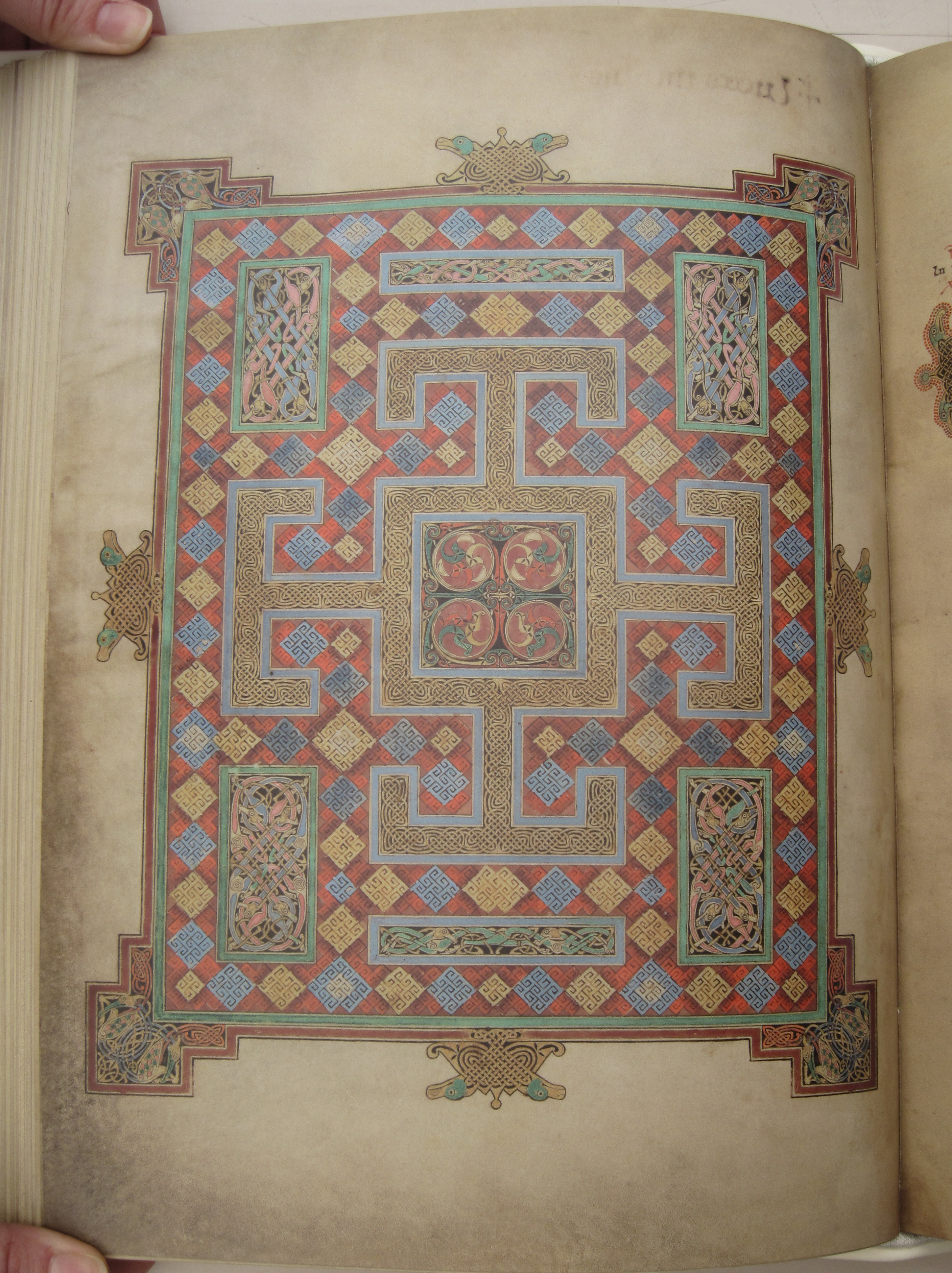
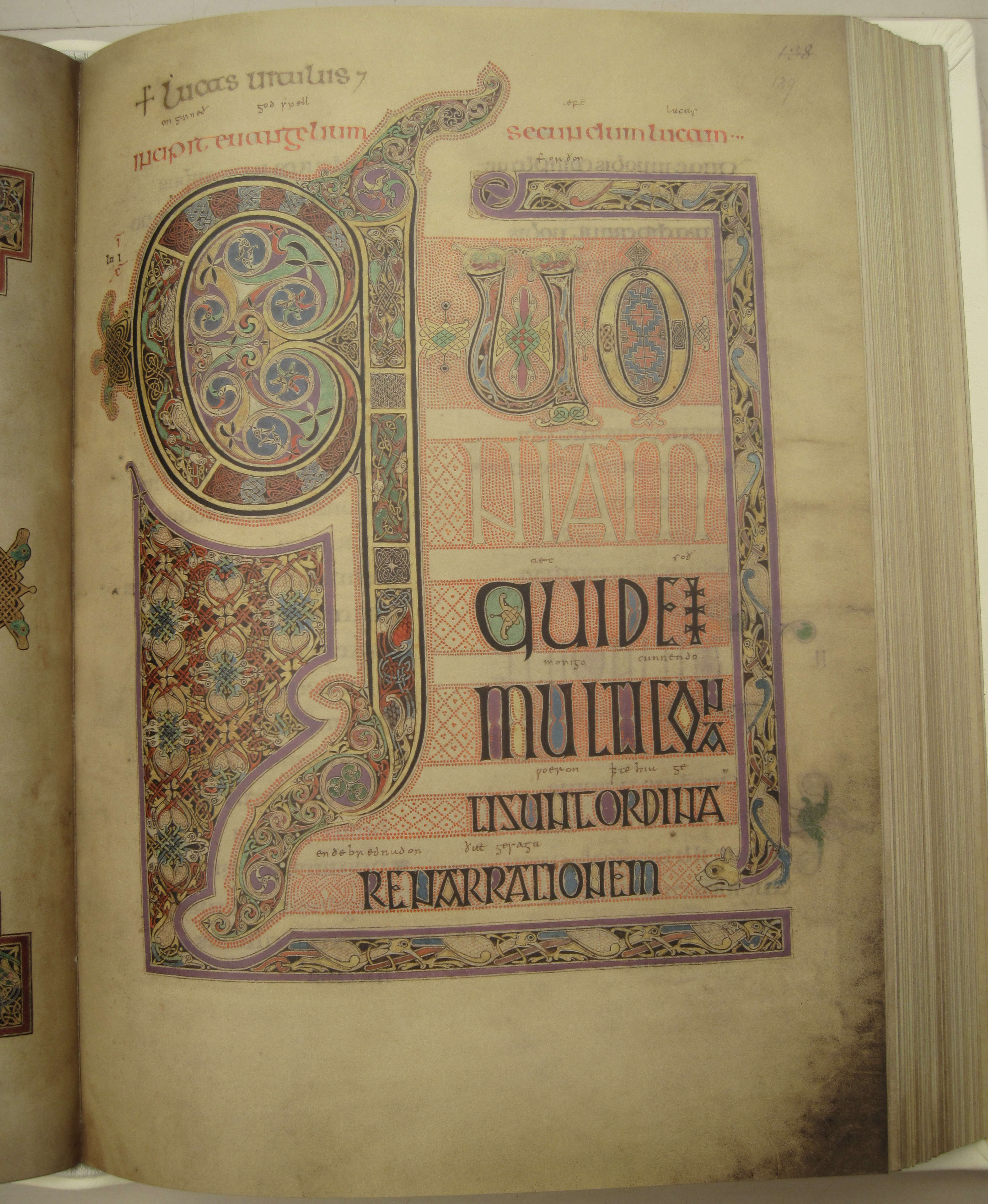
To read more about the Weinberg Library’s Rare Book Collection visit our collection page here. “From Medieval to Modern” will be on display during normal library hours through Tuesday, April 25. On Tuesday, April 11th, Special Collections Librarian Michael Knies will discuss the exhibit at 6 p.m. in the Heritage Room of the Library. A reception will immediately follow the talk. This event is free and open to the public. For more information, please email michael.knies@scranton.edu or call 570- 941-6341.